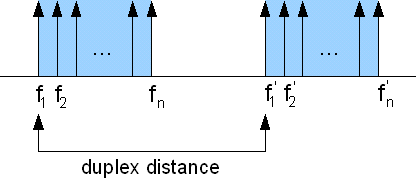
|
| Paired spectrum |
Paired spectrum |
Radio spectrum is often organised (and sold) as paired spectrum - a block of spectrum in a lower frequency band and an associated block of spectrum in an upper frequency band. This arrangement of frequency bands with one band for the uplink and one band for the downlink is called paired spectrum.
In this frequency block a number of frequency channels are paired with associated frequency channels in the other block. One frequency channel is transmitting in one direction (e.g. downstream from a base station to a fixed subscriber terminal). A second frequency is used in the opposite direction (e.g. upstream from the subscriber terminal to the base station). The frequency pair is separated by a "duplex distance" to provide isolation of the two signals. If the two paired frequencies are too close to each other, the transmitter can overload the receiver.

|
| Paired spectrum |
Paired spectrum is often specified in a form like "2x15 MHz" meaning 15 MHz in a lower band and 15 MHz in an upper band. This technique of two users talking to each other on two separate frequencies is called Frequency Division Duplex (FDD).